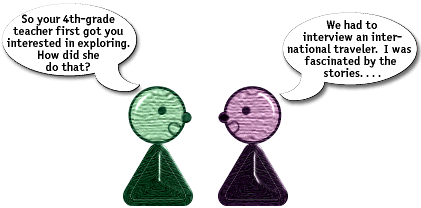|
Module 1 Module 2 Module 3 Module 4 Module 5 Module 6 Module 7 |
|
Application 1 Application 2 Application 3 Application 4 Application 5 Application 6 Application 7 |


Stage 5: Conducting the Interview.
Central to conducting the information interview is establishing a productive interview climate. A productive interview climate does not happen magically; it develops in the interactions between interviewer and interviewee.
Like speeches, interviews have an opening, body, and closing. As the interviewer, you want to begin the interview in such a way that facilitates the interview process, ask questions that assist all parties in achieving their goals, and end the interview on a positive note.
In conducting the information interview, you want to be prepared, yet flexible, and create a communication climate in which the interviewee will feel comfortable. Balance note-taking with maintaining eye contact with the interviewee. If you record the interview, be sure to ask the interviewee's permission before the interview. Don't rely solely on the audiotape for recording the interview as tape recorders can fail. Signal your interest, but avoid leading the interviewee to respond in particular ways. Listen carefully, ask secondary/probing questions, and use your Interview Guide to keep you on track.

Description
The interview opening usually sets the tone for the remainder of the interview. Your goal is to establish a productive climate so both you and your interviewee will participate freely and communicate accurately.
This is the main part of the interview. In Module 4 you learned what kinds of questions you can ask in the information interview. Here we'll look at the order or sequences in which you might ask those questions.
Use this question sequence when the interviewee knows the topic well and feels free to talk about it, or when the person wants to express strong feelings. This is the most common of all question sequences for all types of interviews. In this sequence, the interviewer begins with broad, open-ended questions and moves to more narrow, closed-ended questions. The interviewer may also begin with more general questions and gradually ask more specific questions.
This question sequence is effective when an interviewee needs help remembering something or to motivate an interviewee to talk. In this sequence, the interviewer begins with narrow, closed-ended questions and moves to more broad, open-ended questions. The interviewer may also begin with more specific questions and gradually ask more general questions.
The Diamond question sequence combines the Funnel and Inverted Funnel sequences. Use this sequence when dealing with topics interviewees may find painful or difficult and therefore are reluctant to discuss. Begin with specific, closed-ended questions about a situation similar to the interviewee's, then ask general, open-ended questions about the interview, and finally ask specific, closed-ended questions about the interviewee's particular circumstances.
In this sequence, all questions have the same degree of openness. Also called the "string of beads" questions sequence, the Tunnel sequence allows for little probing and variation in question structure. It can be useful for simple, surface information interviews, but not for in-depth interviews.
APPLICATION 5